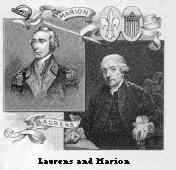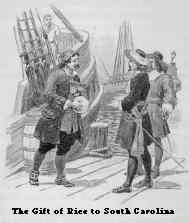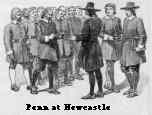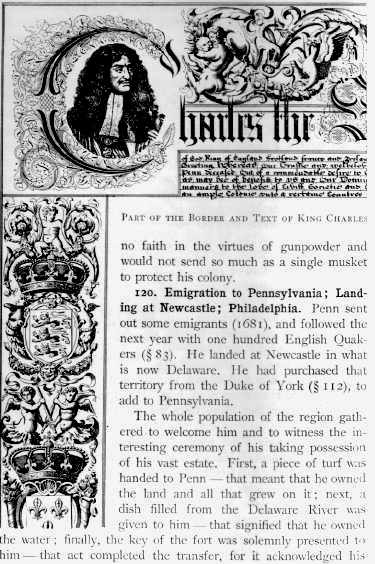Resource Center OLLibrary
|
98 |
|
[1670-1680 |
|
associates. Out of compliment to the King the
territory was called Carolina.1 On the coast
it embraced the entire region now included in the states
of North and South Carolina, Georgia, and a part of
Florida; like Virginia (§ 43), Massachusetts (§
77), and Connecticut (§ 98), it extended westward to
the Pacific. |
|
1693-1712 ] |
|
99 |
and General Marion,1 the noble Revolutionary leader
-- won imperishable renown by their services in the cause of
American liberty.
116. The "Grand Model"; Division of the
Territory into North and South Carolina. Meantime (1670), the
eminent English philosopher, John Locke, had drafted a
constitution for Carolina, called the "Grand Model."
The "Grand Model" established a nobility who
practically held all power. It also set up courts of justice
intended to regulate everything from the gravest questions of law
down to the cut of a man's coat, or the trimming of a woman's
bonnet.
This remarkable constitution gave the common
people no rights. They could not vote; they could not hold landed
property; they could not even leave the soil they tilled, without
permission from the nobleman who owned it. When a wealthy planter
bought a tract of land in Carolina he expected to purchase the
white laborers on it: they, like the trees and the stones, were
considered a part of the estate.
But most of the inhabitants of the territory
decidedly objected to the "Grand Model" They were resolved to own
themselves, to own the labor of their hands, to own all the land
they could honestly buy, and, lastly, to make their own laws.
After twenty years of contest they succeeded. The colony was
eventually divided (1712) into North and South Carolina, and from
that time until the Declaration of Independence (1776) each was
subject to a governor appointed by the King.
117. Growth of the Two Colonies; Introduction
of Rice and Indigo Culture; Charleston. The growth of North
Carolina was very slow, and the manufacture of pitch, tar, and
turpentine did not tend to build up large towns.
In South Carolina, Charleston made little
progress for the first twenty years. But about that time (1693)
the Captain of a vessel coming from the Far East gave the Governor
of the colony a bag of rice to plant as an experiment. He
distributed the rice
1 General Marion: one
of the heroes of the War of Independence (§ 184). His epitaph
declares with entire truth that he "lived without fear, and died
without reproach."
|
100 |
|
[1741 |
|
|
|
1681 ] |
|
101 |
|
governing themselves. North Carolina engaged in the manufacture of tar, pitch, and turpentine; South Carolina began the culture of rice and indigo, both of which proved highly profitable. At the time of the Revolution Charleston was one of the chief cities of America.
119. Grant of Pennsylvania to
William Penn; the "Holy Experiment." Charles II owed
William Penn, the most influential of the English
Friends, or Quakers (§ 83), a large sum of money. As
that good-natured but extravagant monarch always
contracted as many debts as possible and paid as few,
Penn suggested to his Majesty that he might easily settle
his claim by granting him a tract of land in America. The
proposition pleased the King and he gave Penn a territory
of about forty-eight thousand square miles fronting on
the Delaware River. Charles named this vast region (which
was nearly as large as the whole of England)
Pennsylvania, or Penn's Woods. Penn was well known in
Europe for his fair dealing. Everybody had confidence in
him. For this reason not only English Quakers but many
Germans got ready to emigrate to Pennsylvania. |
|
101 |
|
[1638 |
1681-1683] |
|
102 |
 115.
Settlement of Charleston; the Huguenots. The first
settlement direct from England was made (1670) on the
banks of the Ashley River, in the southern part of
Carolina.
115.
Settlement of Charleston; the Huguenots. The first
settlement direct from England was made (1670) on the
banks of the Ashley River, in the southern part of
Carolina. among
the planters and they set their slaves to raising it. In
time South Carolina became the largest rice-producing and
rice exporting state in the Union.
among
the planters and they set their slaves to raising it. In
time South Carolina became the largest rice-producing and
rice exporting state in the Union. XII.
PENNSYLVANIA (1681)
XII.
PENNSYLVANIA (1681)




